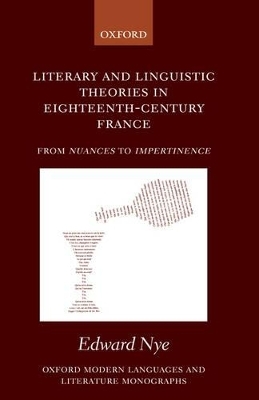
Literary and Linguistic Theories in Eighteenth-Century France
From Nuances to Impertinence
Seiten
2000
Clarendon Press (Verlag)
978-0-19-816012-0 (ISBN)
Clarendon Press (Verlag)
978-0-19-816012-0 (ISBN)
"Linguistic" theories in the 18th century are also theories of literature and art, and it is probably better, therefore, to think of them as "aesthetic" theories. This work considers a wide range of authors from this perspective.
Linguistic' theories in the eighteenth-century are also theories of literature and art, and it is probably better, therefore, to think of them as 'aesthetic' theories. As such, they are answers to the age-old question 'what is beauty?', but formulated, also, to respond to contemporary concerns. Edward Nye considers a wide range of authors from these two perspectives and draws the following conclusions: etymology is a theory of poetry, dictionaries of synonymy, prosody and metaphor are theories of preciosity, and Sensualism is a theory of artistic representation. The background to these contentions is outlined in Chapter One, in which Edward Nye traces the rise of the term 'nuances' as an attempt by contemporary authors to understand representation in art as a rationalization of chaotic reality. The demise of these contentions at the end of the century is described in the last chapter, in which the dominant language theory of the day, idéologie, is shown to be antagonistic to the study of art and literature. Theories of language are no longer an answer to the question 'what is beauty?'
Linguistic' theories in the eighteenth-century are also theories of literature and art, and it is probably better, therefore, to think of them as 'aesthetic' theories. As such, they are answers to the age-old question 'what is beauty?', but formulated, also, to respond to contemporary concerns. Edward Nye considers a wide range of authors from these two perspectives and draws the following conclusions: etymology is a theory of poetry, dictionaries of synonymy, prosody and metaphor are theories of preciosity, and Sensualism is a theory of artistic representation. The background to these contentions is outlined in Chapter One, in which Edward Nye traces the rise of the term 'nuances' as an attempt by contemporary authors to understand representation in art as a rationalization of chaotic reality. The demise of these contentions at the end of the century is described in the last chapter, in which the dominant language theory of the day, idéologie, is shown to be antagonistic to the study of art and literature. Theories of language are no longer an answer to the question 'what is beauty?'
Edward Nye is University Lecturer in French, and Fellow of Lincoln College, Oxford
LIST OF FIGURES; INTRODUCTION; CONCLUSION; APPENDIX; BIBLIOGRAPHY; INDEX
| Erscheint lt. Verlag | 19.10.2000 |
|---|---|
| Reihe/Serie | Oxford Modern Languages and Literature Monographs |
| Zusatzinfo | 6 black and white illustrations |
| Verlagsort | Oxford |
| Sprache | englisch |
| Maße | 146 x 224 mm |
| Gewicht | 426 g |
| Themenwelt | Geisteswissenschaften ► Philosophie ► Sprachphilosophie |
| Geisteswissenschaften ► Sprach- / Literaturwissenschaft ► Anglistik / Amerikanistik | |
| Geisteswissenschaften ► Sprach- / Literaturwissenschaft ► Literaturgeschichte | |
| Geisteswissenschaften ► Sprach- / Literaturwissenschaft ► Literaturwissenschaft | |
| Geisteswissenschaften ► Sprach- / Literaturwissenschaft ► Sprachwissenschaft | |
| Sozialwissenschaften | |
| ISBN-10 | 0-19-816012-7 / 0198160127 |
| ISBN-13 | 978-0-19-816012-0 / 9780198160120 |
| Zustand | Neuware |
| Haben Sie eine Frage zum Produkt? |
Mehr entdecken
aus dem Bereich
aus dem Bereich
Macht und Legitimität politischer Sprache im Prozess der europäischen …
Buch | Softcover (2023)
Nomos (Verlag)
CHF 103,60
Wie die Menschheit zu ihrer größten Erfindung kam
Buch | Softcover (2022)
C.H.Beck (Verlag)
CHF 25,20


